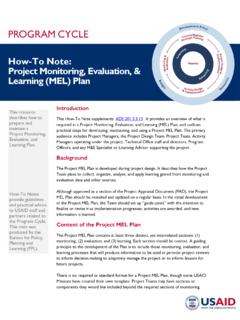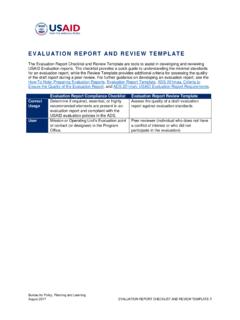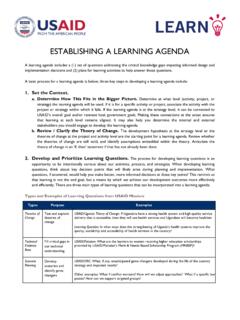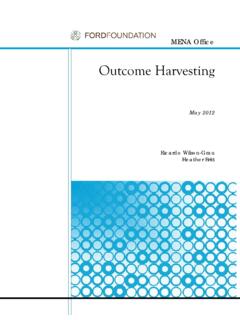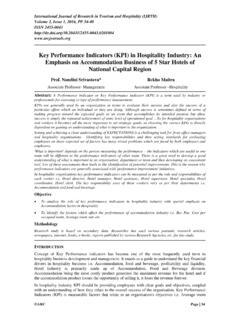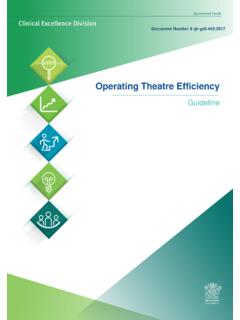Transcription of How-To Note: Developing a Project Logic Model
1 Introduction This How-To Note describes considerations for Developing a Project Logic Model , as well as steps for thinking through a more complete theory of change (TOC). A Logic Model is a graphic or visual depiction that summarizes key elements of a TOC, and it is often used as a facilitation tool during the design process. There are many types of Logic models, including but not limited to logical frameworks (logframes), results chains, results frameworks, and local actor-oriented models, among others. The Project Logic Model and its associated TOC are included in the Project Appraisal Document (PAD) that approves a Project design (see ADS ). While this How-To Note focuses on Logic models at the Project level, Logic models are also used at the strategy level (specifically, results frameworks see Box 1), and often at the activity level.
2 The concepts and steps presented here are generally applicable to the process of Developing Logic models and TOCs throughout the Program Cycle. Background During USAID s Project design process, teams must develop a TOC describing how and why a Project purpose is expected to be achieved in a given context, and an accompanying Logic Model providing a graphic or visual depiction that summarizes this TOC. A complete TOC includes five components: 1. The context in which the development problem is situated; 2. If-then (causal) outcomes needed to achieve the desired change; 3. Major interventions that USAID and others will undertake to catalyze these outcomes; 4. Key assumptions that underlie the success of this theory; and 5. key indicators to monitor how progress unfolds during implementation. PR OGRAM CYCLE How-To Note: Developing a Project Logic Model (and its Associated Theory of Change) This How-To Note describes steps and considerations for Developing a Project Logic Model (and its associated theory of change).
3 How-To Notes provide guidelines and practical advice to USAID staff and partners related to the Program Cycle. This note was produced by the Bureau for Policy, Planning and Learning (PPL) VERSION 2 / JULY 2017 PAGE 2 The Logic Model is a snapshot or approximation of this TOC; it is not an exact representation, and often does not include all of these elements. What is highlighted in the Logic Model will depend on its intended application and the degree of detail that the team opts to include in this summary presentation. Logic Models Are Multi-P urpose Tools Logic models are useful tools for several reasons. First, if done well, they can help ensure that planning is done with the end in mind1, rather than focusing initially on resources or on the interventions to be performed. They can also be powerful instruments for guiding the monitoring and evaluation of projects, and indeed, some of the biggest proponents of Logic models are those in the evaluation community, who rely on clear theories about how and why, and under what assumptions, a Project is expected to achieve its Managers also often value Logic models for providing a programmatic roadmap and an organizing framework for learning and adapting, as well as a powerful communications device to show stakeholders at a glance what the Project is about.
4 Moreover, the process of Developing the Logic Model is often as important as the Logic Model itself, as it can help the team think through the TOC. When done in a group, the process can provide an opportunity to expose different beliefs about how change is expected to take place and expand thinking beyond conventional interventions, as well as promote shared buy-in around the ultimate approach. For this reason, it s important to include diverse stakeholders in the Project design team so that current paradigms can be challenged and new approaches can be considered. 1 Covey, Stephen R., The 7 Habits of Highly Effective People: Restoring the Character Ethic. New York: Free Press, 2004. 2 At USAID, theories of change and associated Logic models are a critical foundation for Developing whole-of- Project performance evaluations, a requirement in ADS BOX 1: THE Project Logic Model AND TOC IN THE CONTEXT OF THE PROGRAM CYCLE A Logic Model is a visual or graphic depiction that is a snapshot of a more complete TOC.
5 The relationship between the Project Logic Model and its TOC is analogous to the relationship between the CDCS results framework (RF) and its development hypothesis. An RF is a type of Logic Model , and a development hypothesis is a synonym for a theory of change. Similarly, many activities have their own Logic models and TOCs. Ideally, Logic models/TOCs for the CDCS and its subsidiary projects and activities would be developed chronologically, with one flowing seamlessly downward into the next. In reality, however, development of the Logic models/TOCs at each planning level is a highly iterative process that is refined as the context continues to evolve, new analysis is conducted, and lessons are learned over the course of implementation. The Project Logic Model and TOC are therefore never finished products (just as the RF and development hypothesis are never finished products); they re a starting point that reflect the team s best thinking at that moment in time, and should therefore be revisited and updated as needed.
6 VERSION 2 / JULY 2017 PAGE 3 Logic Models Come in Many Shapes and Sizes As Project planners seek new and creative ways to represent their Project designs, Logic models are increasingly varied and can be displayed by a wide variety of methods. Logic models can be: Simple or elaborate A table, flowchart, or combination of these Bottom-to-top, or left-or -right, or maybe even circular Time-sequenced, or divorced from time Logically linear with cause always leading to effect, or a more nuanced Model that displays multi-directional relationships where effect can feed back into cause (or causes) and vice versa From the 30,000-foot view, or more of an on-the-ground view Some of these approaches may be preferred for engaging stakeholder groups during the design process, while others may be preferred for communications purposes, or to be used as monitoring tools.
7 In many cases, teams may opt for a family of Logic models, with a simple parent version at a high level and nested versions focusing on different aspects of the design. This may be a particularly useful approach for USAID Project designs since they are often large and multi-faceted, and a single Logic Model may not be able to capture this complexity. Logic Models Are a Snapshot of a TOC Logic models are a snapshot of a theory of change. They do not reflect all of the nuance in a TOC, nor do they necessarily include all of the components. The five components of a complete TOC include: 1. The context (or system) in which the development problem is situated. This includes the root causes or drivers underlying the development problem, as well as circumstances or conditions in the operating context that may affect intended Project outcomes and are likely to change.
8 BOX 2: ASSUMPTIONS There are two types of assumptions: programmatic assumptions and context assumptions. Programmatic assumptions are the (often implicit) ways in which key outcomes are expected to contribute to the next level of outcome. Context assumptions are those external factors in the Project context that are also outside the Project manager s control, but are nevertheless necessary for success. In both cases, there should be a reasonable likelihood that the assumptions will hold true since they form part of the theory of change and are conditions that are important to the Logic working as intended. VERSION 2 / JULY 2017 PAGE 4 2. If-then (causal) outcomes3 that are expected to be achieved as a result of the Project s interventions. These outcomes should establish the causal relationships between the elements of a Project leading to the Project purpose.
9 The TOC may also show feedback loops where effect is expected to feed back into cause and vice versa, to continually increase or reduce the magnitude of the original outcome. (See Annex 1 for additional guidance on feedback loops.) 3. Major interventions that the Project intends to implement to directly or indirectly influence this set of outcomes. 4. Key assumptions articulating the conditions, behaviors, and/or critical events outside the control of the Project that must prevail for the Logic to work as intended. Assumptions form part of the complete TOC regarding the conditions under which change is envisioned to occur. Assumptions may be listed within the Logic Model itself, or to the side. At a minimum, they must be described in the TOC. See Box 2 for a discussion of different types of assumptions.
10 5. Indicators to measure the most important expected Project outcomes and assumptions. Indicators can be listed alongside the outcomes or assumptions that that they represent within the Logic Model . At a minimum, they must be captured in the Project Monitoring, Evaluation and Learning (MEL) Plan. See Annexes 1A D and Annex 2 for a few examples of different types of Logic models. 3 The terminology can differ from Logic Model to Logic Model ; however, typical terminology includes outputs, outcomes, results, purpose, and/or goal. (To avoid confusion, this document just refers to outcomes, or lower order to higher order outcomes. ) BOX 3: COMPLEXITY IS AN IMPORTANT CONSIDERATION An important consideration during development of a Project s TOC is the nature of the development problem addressed by the design, and the context in which the design will be situated.




